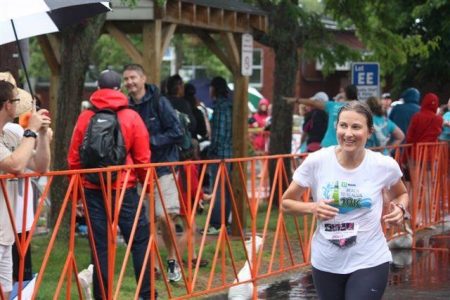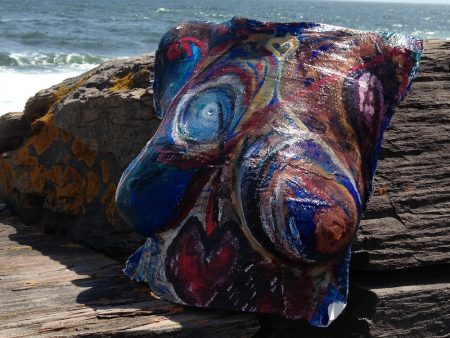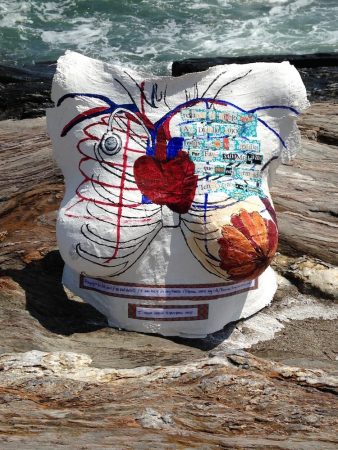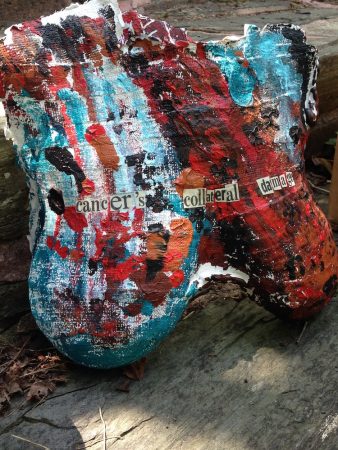Stephanie McLeod-Estevez is an expressive arts therapist who recently used the tools of her trade to help heal herself. Stephanie was diagnosed with breast cancer in 2014.
As a therapist, she had noticed how pervasive grief was in people’s lives. She realized that helping people through the process of grieving and letting go was important work. Because sometimes people aren’t able to express their feelings in words, she began to use art as a therapy tool. “Using the arts is a way of accessing some of the process — to enable you to bring it outside of you and, like a suitcase, unpack what has been inside and ultimately putting it back together again.”
Using art to heal herself
As she went through her own grieving process after finding out she had breast cancer, Stephanie decided to try some art therapy on herself. At different stages of her journey, she created plaster casts of her breasts. “My process,” she explains, “was to sit down separately and connect to the feelings, sensations, and thoughts of each experience and then creatively express that on each cast.”
Diagnosis
With her first cast, Stephanie described her feelings about being diagnosed with breast cancer.
An uproar of mixed thoughts, feelings and reactions all happening at once. My heart is in the pit of my stomach. Things are moving fast and I feel off kilter trying to keep up with the testing, information, new reality, recommendations for treatment, fear, the implications for myself, my family, my children, fragility and vulnerability. Yet, I can see a glimmer of hope, peacefulness, a deep reservoir of strength that is holding me in place, helping me to surrender to the process and trust that I was going to be ok.
Chemotherapy
A second cast, depicting chemotherapy, is almost devoid of the feelings she expressed about her diagnosis.
This is the moment where I am on my knees, pleading for my life, asking the red devil (aka Adryomicin) and the other chemos to do their job and kill this cancer. I am acutely aware of the port that has surgically entered my body, my veins, and I’m a little fearful of how the port could carry an infection straight to my heart. The cast is stark, the path is clear cut in terms of what we are doing and why. I can now feel my cancer (seen on left side of breast), my tumor, when I dance and then — one week into treatment — there is a palpable difference to how the tumor feels. It is no longer rock hard, but soft and more malleable. My oncologist and I share this moment of triumph and hope. I have never felt so close to a provider —a life saver — than I have in this moment. Yet the risks of treatment to the heart must be carefully monitored. We are in a clinical moment. My blood tells the story of how my body is responding to the toxic medicine.
Helping others get on with their lives
Making the plaster casts was powerful healing medicine for Stephanie. She also reached out for support in other ways and discovered that when it came to dealing with life after cancer, there seemed to be a hole.
As a result, she founded her business Creative Transformations and now teaches people how to use art and meditation to heal the mind, body, spirit and self. People like Molly Anderson, who was also diagnosed with breast cancer.

Molly Anderson doing the Tri for a Cure
“I had thought about doing traditional support groups or traditional therapy, but just never did it,” Molly told me. “Stephanie explained what she was doing and it sounded like something that would be great. I’m not the least bit artistic, in fact, very far from it. But she gets you comfortable with the materials you’re working with before you start to get your expressions out on paper. You get comfortable with just doing it.”
Molly and Stephanie had four sessions together. Each one began with a meditation and deep breathing. Then Stephanie led her through a particular topic — her body, for instance. “She would prompt me,” says Molly. “Your body has gone through all these changes. How would you describe your relationship with your body before this trauma? Then she asked how I would describe it now. We would talk and she would prompt me to express my feelings artistically.”
One of the things Molly told Stephanie was how when she took a shower, she was more afraid of her body. Afraid that she’d find another lump or a recurrence. Stephanie explained how colors can represent feelings and suggested that imagining sunshine and a yellow color might help allay or redirect her fear.
Molly created a bright yellow image and now that’s what comes to her mind whenever she steps into the shower. “Every time I go into the shower, I think about bringing in the warm yellow,” she says. “It definitely helped me.”
She drew another image that was mostly a “black spiky cloudy thing” that represented the devastation she felt when she got her diagnosis. The point was not to draw something recognizable but simply to express her feelings in a non-verbal way. “Stephanie explained to me that it’s a way to get them out of your body, which is very therapeutic because they’ve got to come out. That’s part of the therapy process — to transition into a recovery situation — not to hold all that in, but to process it.”
It’s a lesson that Stephanie learned as she navigated her own healing process. Along the way, she came to realize that her experience was going to have a transformative effect on her life. “It’s one of the things that kept me feeling grounded and resilient and able to focus on all the things I needed to do,” she says.
Mastectomy
As part of her treatment, Stephanie had a double mastectomy. This cast describes her feelings about why she had the surgery and the effect it had on her.
Cancer’s collateral damage is undeniable with this life-saving intervention. Most of my breasts are unaffected by the disease. However, given the aggressive nature of my particular breast cancer (triple negative) and my brca2+ status, they become the breeding ground for future illness. In fact, they find stage 0 DCIS in the other breast (non-cancer breast) when the pathology is done. My body betrays me again. I painted this completely by hand — no brushes. I wanted to feel it go on. It’s such a visceral loss to undertake, even when you have no regrets. Feeling tainted by the disease and grieving the loss of my breasts that comforted and fed my children. Losing their natural softness, femininity. Expanders holding the possibility of a reconfigured and reconstructed chest, yet the canvas feels so blank as the nipples no longer exist. It takes time to view the new me and recover from the physical damage of surgery.
Upcoming presentation
Stephanie’s personal story is cancer-related and she works with other people who have cancer, but she believes what she does could be helpful for anyone who is grieving. After all, she says, “grief is grief.”
To learn more about Stephanie’s work, visit her website Creative Transformations.
She will also be speaking and showing her plaster casts at an upcoming presentation at the Cancer Community Center.
A Breast Cancer Story Through Art
with Stephanie McLeod-Estevez
Cancer Community Center
778 Main Street, South Portland, ME
Wednesday, October 19
4:00 to 6:00





Leave A Comment